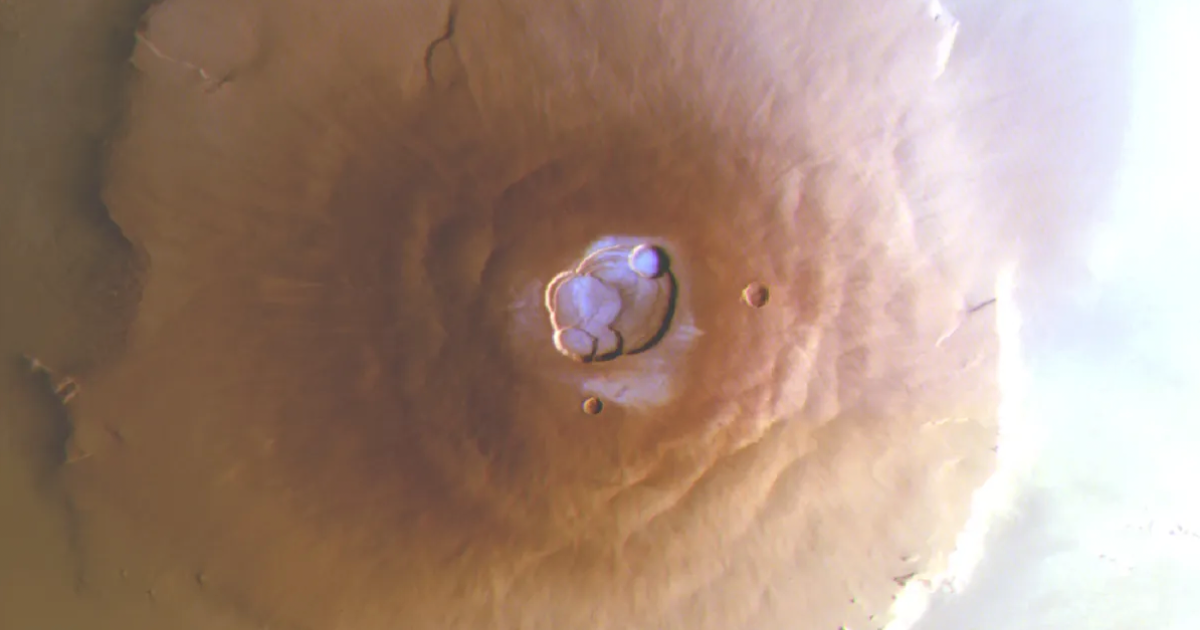
Scientists and researchers are always keen to find water out there in the universe, and of course we know why.
Water could mean at least the potential for life.
And we’re all dying to find that!
Now, they’re finding water ice in some unexpected places – and unexpected altitudes, for that matter.
This time, it’s on the highest peaks of the volcanoes in the Tharsis region that show traces of frost – actually water ice, not frozen carbon dioxide.
Mars’ thin atmosphere is mostly made of carbon dioxide, and its extinct volcanoes rise through it – the biggest of which is Olympus Mons, which is around 370 miles in diameter.
That’s about the size of Arizona, for reference.
It’s around 15.5 miles high, which is around 3x as high as the highest mountain on Earth.
The other volcanoes – Arsia Mons, Pavonis Mons, and Ascraeus Mons, are all between 8-11 miles high.
No one expected water ice to be condensed on the calderas due to the thin atmosphere, says Adomas Valantinas, the lead author on the study.
“We thought it was impossible for frost to form around Mars’s equator, as the mix of sunshine and thin atmosphere keeps temperatures relatively high at both surface and mountaintop – unlike what we see on Earth, where you might expect to see frosty peaks. It’s existence here is exciting, and hints that there are exceptional processes at play that are play that are allowing frost to form.”
This water ice event joins another, a water ice cloud that forms from Arsia Mons during the Martian spring.
The volcanoes seem to focalize the little moisture present in the Martian atmosphere into an area at the top, forming ice, says co-author Nicolas Thomas.
“Winds travel up the slopes of the mountains, bringing relatively moist air from near the surface up to higher altitudes, where it condenses and settles as frost. We actually see this happening on Earth and other parts of Mars, with the same phenomenon causing the seasonal martian Arsia Mons Elongated Cloud. The frost we see atop Mars’s volcanoes appears to settle in the shadowed regions of the calderas especially, where temperatures are colder.”
You might be wondering why we’ve never seen this before, considering how well these volcanoes have been studied in the past, and Valantinas has an answer.
“There are a few reasons: firstly, we need an orbit that lets us observe a location in the early morning. While ESA’s two Mars orbiters – Mars Express and TGO – have such orbits and can observe at all times of day, many from other agencies are instead synchronised to the Sun and can only observe in the afternoon.”
And that’s not the only possibility.
“Secondly, frost deposition is linked to colder martian seasons, making the window for spotting it even narrower. In short, we have to know where and when to look for ephemeral frost. We happened to be looking for it near the equator for some other research, but didn’t expect to see it on Mars’s volcano tops!”
Look for a lot more research into water on Mars, as it will be important for future explorations of the planet, particularly by human beings.
For now, this is very encouraging news.
If you thought that was interesting, you might like to read about a second giant hole has opened up on the sun’s surface. Here’s what it means.